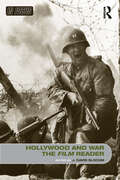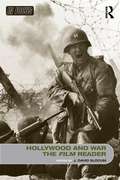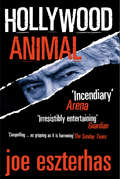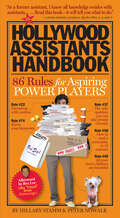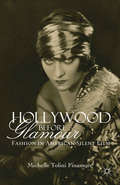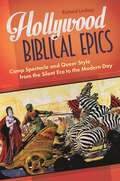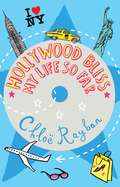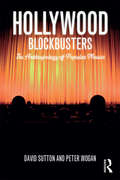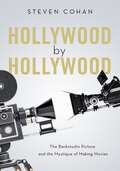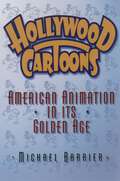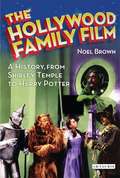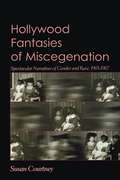- Table View
- List View
Hollywood and the Nazis on the Eve of War: The Case of The Mortal Storm
by Alexis PogorelskinThis book establishes the profound significance of MGM's 1940 film The Mortal Storm, the first major Hollywood production to depict the plight of Jews in Germany before the Holocaust. Based on Phyllis Bottome's best seller, also titled The Mortal Storm, the film was made amidst the bitter debate that occurred between 1938 and 1941 over whether the United States should involve itself in another European war or remain an isolationist country, as Charles Lindbergh among others urged. In 1941, the film triggered the first hostile Congressional investigation of Hollywood where the studios were accused of allegedly propagandizing for war. Lindbergh had secretly urged the Hollywood hearings, inspired by his own growing antisemitism, as his unpublished diary reveals. Hollywood studios, in turn, regarded the growing European crisis with ambivalence. They feared being accused in a film like The Mortal Storm of using the movies to represent the fate of Europe's imperiled Jews. Louis B. Mayer, the head of MGM, insisted the word “Jew” be removed from the film and “non-Aryan” be used instead, hoping to confuse American audiences about the film's real intent. Jimmy Stewart, who starred in the film, took it on the road to urge American aid to Britain, while Lindbergh prepared his own campaign to denounce American Jews for luring the country into war. The book reveals how closely Hollywood and politics were entwined on the eve of war. It also reveals how closely the plight of Europe's Jews and American antisemitism were entwined at the same time.
Hollywood and War, The Film Reader
by J. David SlocumDiscussing such classic films as Sergeant York, Air Force, and All Quiet on the Western Front, as well as more modern blockbusters like Apocalypse Now and Saving Private Ryan, this outstanding volume focuses on Hollywood and its production of war films.Topics covered include:the early formation of war cinemathe apotheosis of the Hollywood war filmthe ascendancy of ambivalenceHollywood and the war since Vietnamwar as a way of seeing. For any student of film studies or American cultural studies, this is a valuable companion.
Hollywood and War, The Film Reader
Discussing such classic films as Sergeant York, Air Force, and All Quiet on the Western Front, as well as more modern blockbusters like Apocalypse Now and Saving Private Ryan, this outstanding volume focuses on Hollywood and its production of war films.Topics covered include:the early formation of war cinemathe apotheosis of the Hollywood war filmthe ascendancy of ambivalenceHollywood and the war since Vietnamwar as a way of seeing. For any student of film studies or American cultural studies, this is a valuable companion.
Hollywood and War, The Film Reader (In Focus: Routledge Film Readers Ser.)
by J. David SlocumDiscussing such classic films as Sergeant York, Air Force, and All Quiet on the Western Front, as well as more modern blockbusters like Apocalypse Now and Saving Private Ryan, this outstanding volume focuses on Hollywood and its production of war films. Topics covered include: the early formation of war cinema the apotheosis of the Hollywood war film the ascendancy of ambivalence Hollywood and the war since Vietnam war as a way of seeing. For any student of film studies or American cultural studies, this is a valuable companion.
Hollywood Animal: A Memoir
by Joe EszterhasHe spent his earliest years in post-World War Two refugee camps. He came to America and grew up in Cleveland - stealing cars, rolling drinks, battling priests, nearly going to jail. He became the screenwriter of the world-wide hits Basic Instinct, Jagged Edge and Flashdance. He also wrote the legendary disasters Showgirls and Jade. The rebellion never ended, even as his films went on to gross more than a billion dollars at the box office and he became the most famous - or infamous - screenwriter in Hollywood.
The Hollywood Assistants Handbook: 86 Rules for Aspiring Power Players
by Peter Nowalk Hillary StammAre you young, eager, smart, and heading off to LA to make it big in the entertainment business? Time for a reality check: Leave your diploma at home, put your grandiose dreams on hold (where hopefully they'll get tired and hang up), and start by repeating the first rule of the industry: Who you work for is more important than who you are. Then leapfrog over everyone else by reading The Hollywood Assistants Handbook. Written by two very sharp and successful assistants to HPPs (Hollywood Power Players), here are 86 lessons packed with a combination of blunt truth, insider humor, and juicy secrets that explain the unwritten rules of how to get a foot in the door and make all the right moves as you climb to the top. Here are the minimum-wage jobs that will put you in the path of HPPs. An annotated resume roundup. The clubs to frequent and the cocktails to order. Movies to watch and books to read (it's called homework). Dressing do's and don'ts. How to get on the Free List. A lineup of boss genres—the Horror Show, the Romantic Comedy, Mr. Action—and how to dodge the tirades that will soon be hurled your way, along with the proper outlets for venting. Plus, the ins and outs of your most important tool, the telephone—when to listen in (always!), who to put through and who to put off, and your new best friend forever, the Plantronics CS70 cordless headset. With its hilariously snarky tone—the gate-keeping quiz is "How to Tell if You're a Moron Who Should Pack Up the Corolla and Move Back Home"—The Hollywood Assistants Handbook is as baldly entertaining for everyone who loves reading about Hollywood as it is indispensably practical for the job-seeker.
Hollywood Before Glamour: Fashion in American Silent Film
by M. Tolini FinamoreThis exploration of fashion in American silent film offers fresh perspectives on the era preceding the studio system, and the evolution of Hollywood's distinctive brand of glamour. By the 1910s, the moving image was an integral part of everyday life and communicated fascinating, but as yet un-investigated, ideas and ideals about fashionable dress.
Hollywood Biblical Epics: Camp Spectacle and Queer Style from the Silent Era to the Modern Day
by Richard LindsayThis is the only book of its kind to explore biblical epics from an LGBT perspective, studying films from the silent era, to the postwar major studio era, to the present day.In spite of restrictive Hollywood censorship regulations, filmmakers throughout history have pushed the boundaries of sex and violence when making religious films. In this unrivaled text, author and educator Richard Lindsay analyzes the relationship between bible-based epics and "camp"—films with overwrought acting, casts of thousands, and exotic sexuality. Lindsay presents the ways in which camp style identifies films as "biblical" in the mainstream imagination, while undermining their traditional religious messages through the inclusion of sexually diverse subtexts.Viewed through this lens, this provocative book explores topics like the Jazz Age excesses of The King of Kings, the pre-code decadence of The Sign of the Cross, the horror movie tropes of The Passion of the Christ, and comparisons between Ben-Hur and the gay male fantasies of 1960s beefcake magazines. Additional content features the history of biblical epics and a comparison of the pious expectations of filmgoers against the real content of the films.
Hollywood Biblical Epics: Camp Spectacle and Queer Style from the Silent Era to the Modern Day
by Richard LindsayThis is the only book of its kind to explore biblical epics from an LGBT perspective, studying films from the silent era, to the postwar major studio era, to the present day.In spite of restrictive Hollywood censorship regulations, filmmakers throughout history have pushed the boundaries of sex and violence when making religious films. In this unrivaled text, author and educator Richard Lindsay analyzes the relationship between bible-based epics and "camp"—films with overwrought acting, casts of thousands, and exotic sexuality. Lindsay presents the ways in which camp style identifies films as "biblical" in the mainstream imagination, while undermining their traditional religious messages through the inclusion of sexually diverse subtexts.Viewed through this lens, this provocative book explores topics like the Jazz Age excesses of The King of Kings, the pre-code decadence of The Sign of the Cross, the horror movie tropes of The Passion of the Christ, and comparisons between Ben-Hur and the gay male fantasies of 1960s beefcake magazines. Additional content features the history of biblical epics and a comparison of the pious expectations of filmgoers against the real content of the films.
Hollywood Black: The Stars, the Films, the Filmmakers (Turner Classic Movies)
by Donald BogleThe films, the stars, the filmmakers-all get their due in Hollywood Black, a sweeping overview of blacks in film from the silent era through Black Panther, with striking photos and an engrossing history by award-winning author Donald Bogle.The story opens in the silent film era, when white actors in blackface often played black characters, but also saw the rise of independent African American filmmakers, including the remarkable Oscar Micheaux. It follows the changes in the film industry with the arrival of sound motion pictures and the Great Depression, when black performers such as Stepin Fetchit and Bill "Bojangles" Robinson began finding a place in Hollywood. More often than not, they were saddled with rigidly stereotyped roles, but some gifted performers, most notably Hattie McDaniel in Gone With the Wind (1939), were able to turn in significant performances.In the coming decades, more black talents would light up the screen. Dorothy Dandridge became the first African American to earn a Best Actress Oscar nomination for Carmen Jones (1954), and Sidney Poitier broke ground in films like The Defiant Ones and 1963's Lilies of the Field. Hollywood Black reveals the changes in images that came about with the evolving social and political atmosphere of the US, from the Civil Rights era to the Black Power movement. The story takes readers through Blaxploitation, with movies like Shaft and Super Fly, to the emergence of such stars as Cicely Tyson, Richard Pryor, Eddie Murphy, and Whoopi Goldberg, and of directors Spike Lee and John Singleton.The history comes into the new millennium with filmmakers Barry Jenkins (Moonlight), Ava Du Vernay (Selma), and Ryan Coogler (Black Panther); megastars such as Denzel Washington, Will Smith, and Morgan Freeman; as well as Halle Berry, Angela Bassett, Viola Davis, and a glorious gallery of others.Filled with evocative photographs and stories of stars and filmmakers on set and off, Hollywood Black tells an underappreciated history as it's never before been told.
Hollywood Bliss - My Life So Far
by Chloe RaybanHaving fought attempts to turn her into a mini-me pop starlett in book one, Holly finds herself subjected to her mother's egomaniac schemes once again. Plucked from life and friends in London, Holly is transplanted to a 'designer' but far-from-homely penthouse in New York (the convenient epicentre for her mother's music tour). Holly is not impressed.But then when she starts to take stock of her situation, Holly realises it may not be as entirely awful as she first thought: she'll be able to see more of her dad who also lives in Manhattan, it should (officially) be the start of the summer holidays, and there's always a chance that teenage boys in New York will be more enlightened to her charms than boys in England . . . If she can find a way to get rid of her personal tutor, give her bodyguard the slip, and keep her mother from coming up with any new crazy schemes in the immediate future (no easy job), then maybe things could even start to be fun . . .
Hollywood Blockbusters: The Anthropology of Popular Movies
by Peter Wogan David SuttonCertain Hollywood movies are now so deeply woven into the cultural fabric that lines of their dialogue - for example, 'Make him an offer he can't refuse' - have been incorporated into everyday discourse. The films explored in this book, which include The Godfather, Jaws, The Big Lebowski, Field of Dreams and The Village, have become important cultural myths, fascinating windows into the schisms, tensions, and problems of American culture. Hollywood Blockbusters: The Anthropology of Popular Movies uses anthropology to understand why these movies have such enduring appeal in this age of fragmented audiences and ever-faster spin cycles. Exploring key anthropological issues from ritual, kinship, gift giving and totemism to literacy, stereotypes, boundaries and warfare, this fascinating book uncovers new insights into the significance of modern film classics for students of Film, Media, Anthropology and American Cultural Studies.
Hollywood Blockbusters: The Anthropology of Popular Movies
by Peter Wogan David SuttonCertain Hollywood movies are now so deeply woven into the cultural fabric that lines of their dialogue - for example, 'Make him an offer he can't refuse' - have been incorporated into everyday discourse. The films explored in this book, which include The Godfather, Jaws, The Big Lebowski, Field of Dreams and The Village, have become important cultural myths, fascinating windows into the schisms, tensions, and problems of American culture. Hollywood Blockbusters: The Anthropology of Popular Movies uses anthropology to understand why these movies have such enduring appeal in this age of fragmented audiences and ever-faster spin cycles. Exploring key anthropological issues from ritual, kinship, gift giving and totemism to literacy, stereotypes, boundaries and warfare, this fascinating book uncovers new insights into the significance of modern film classics for students of Film, Media, Anthropology and American Cultural Studies.
Hollywood by Hollywood: The Backstudio Picture and the Mystique of Making Movies
by Steven CohanThe backstudio picture, or the movie about movie-making, is a staple of Hollywood film production harking back to the silent era and extending to the present day. What gives backstudios their coherence as a distinctive genre, Steven Cohan argues in Hollywood by Hollywood, is their fascination with the mystique of Hollywood as a geographic place, a self-contained industry, and a fantasy of fame, leisure, sexual freedom, and modernity. Yet by the same token, if backstudio pictures have rarely achieved blockbuster box-office success, what accounts for the film industry's interest in continuing to produce them? The backstudio picture has been an enduring genre because, aside from offering a director or writer a chance to settle old scores, in branding filmmaking with the Hollywood mystique, the genre solicits consumers' strong investment in the movies. Whether inspiring the "movie crazy" fan girls of the early teens and twenties or the wannabe filmmakers of this century heading to the West Coast after their college graduations, backstudios have given emotional weight and cultural heft to filmmaking as the quintessential American success story. But more than that, a backstudio picture is concerned with shaping perceptions of how the film industry works, with masking how its product depends upon an industrial labor force, including stardom, and with determining how that work's value accrues from the Hollywood brand stamped onto the product. Cohan supports his well theorized and well researched claims with nuanced discussions of over fifty backstudios, some canonical and well-known, and others obscure and rarely seen. Covering the hundred-year timespan of feature length film production, Hollywood by Hollywood offers an illuminating perspective for considering anew the history of American movies.
HOLLYWOOD BY HOLLYWOOD C: The Backstudio Picture and the Mystique of Making Movies
by Steven CohanThe backstudio picture, or the movie about movie-making, is a staple of Hollywood film production harking back to the silent era and extending to the present day. What gives backstudios their coherence as a distinctive genre, Steven Cohan argues in Hollywood by Hollywood, is their fascination with the mystique of Hollywood as a geographic place, a self-contained industry, and a fantasy of fame, leisure, sexual freedom, and modernity. Yet by the same token, if backstudio pictures have rarely achieved blockbuster box-office success, what accounts for the film industry's interest in continuing to produce them? The backstudio picture has been an enduring genre because, aside from offering a director or writer a chance to settle old scores, in branding filmmaking with the Hollywood mystique, the genre solicits consumers' strong investment in the movies. Whether inspiring the "movie crazy" fan girls of the early teens and twenties or the wannabe filmmakers of this century heading to the West Coast after their college graduations, backstudios have given emotional weight and cultural heft to filmmaking as the quintessential American success story. But more than that, a backstudio picture is concerned with shaping perceptions of how the film industry works, with masking how its product depends upon an industrial labor force, including stardom, and with determining how that work's value accrues from the Hollywood brand stamped onto the product. Cohan supports his well theorized and well researched claims with nuanced discussions of over fifty backstudios, some canonical and well-known, and others obscure and rarely seen. Covering the hundred-year timespan of feature length film production, Hollywood by Hollywood offers an illuminating perspective for considering anew the history of American movies.
Hollywood Cartoons: American Animation in Its Golden Age
by Michael BarrierIn Hollywood Cartoons, Michael Barrier takes us on a glorious guided tour of American animation in the 1930s, '40s, and '50s, to meet the legendary artists and entrepreneurs who created Bugs Bunny, Betty Boop, Mickey Mouse, Wile E. Coyote, Donald Duck, Tom and Jerry, and many other cartoon favorites. Beginning with black-and-white silent cartoons, Barrier offers an insightful account, taking us inside early New York studios and such Hollywood giants as Disney, Warner Bros., and MGM. Barrier excels at illuminating the creative side of animation--revealing how stories are put together, how animators develop a character, how technical innovations enhance the "realism" of cartoons. Here too are colorful portraits of the giants of the field, from Walt and Roy Disney and their animators, to Bill Hanna and Joe Barbera. Based on hundreds of interviews with veteran animators, Hollywood Cartoons gives us the definitive inside look at this colorful era and at the creative process behind these marvelous cartoons.
Hollywood Cartoons: American Animation in Its Golden Age
by Michael BarrierIn Hollywood Cartoons, Michael Barrier takes us on a glorious guided tour of American animation in the 1930s, '40s, and '50s, to meet the legendary artists and entrepreneurs who created Bugs Bunny, Betty Boop, Mickey Mouse, Wile E. Coyote, Donald Duck, Tom and Jerry, and many other cartoon favorites. Beginning with black-and-white silent cartoons, Barrier offers an insightful account, taking us inside early New York studios and such Hollywood giants as Disney, Warner Bros., and MGM. Barrier excels at illuminating the creative side of animation--revealing how stories are put together, how animators develop a character, how technical innovations enhance the "realism" of cartoons. Here too are colorful portraits of the giants of the field, from Walt and Roy Disney and their animators, to Bill Hanna and Joe Barbera. Based on hundreds of interviews with veteran animators, Hollywood Cartoons gives us the definitive inside look at this colorful era and at the creative process behind these marvelous cartoons.
Hollywood Catwalk: Exploring Costume and Transformation in American Film (International Library Of Cultural Studies)
by Tamar Jeffers McDonaldThe High School outsider takes off her glasses, puts on a dress, and becomes the Prom Queen; the dowdy woman has her hair done, buys some chic new clothes and starts to attract the men. Cinderella and Pygmalion stories still provide inspiration for the plots of Hollywood romantic comedies, dramas, and even action films. Their perennial use prompts a series of questions: is, for example, male agency necessary to effect the transformation, or can the woman change herself? Can she ever change him? Most pressingly, what do these images of change and transformation, of improvement and transcendence tell us, the viewers, about what we should be doing? Investigating these questions, this book examines a key but frequently overlooked aspect of film style: the costume. Across all the films discussed, costume and the body it covers becomes the crucial element in the transformation scene, exemplifying the “before” and “after” of the successful change. Exploring the fantasies of transcendence and transformation sold through these films and exemplified in the costumes, this book examines 'Calamity Jane', 'Midnight Cowboy', 'Clueless', 'The Long Kiss Goodnight', 'The Devil Wears Prada', and many other examples from both classic and contemporary Hollywood.
Hollywood Drive: What it Takes to Break in, Hang in & Make it in the Entertainment Industry
by Eve Light HonthanerHollywood Drive: What it Takes to Break in, Hang in & Make it in the Entertainment Industry is the essential guide to starting and succeeding at a career in film and TV. The completely updated second edition features new interviews with industry professionals, information about the changing social media landscape, the wide array of distribution platforms that are available to aspiring filmmakers, and much more. Honthaner's invaluable experience and advice give those attempting to enter and become successful in the entertainment industry the edge they need to stand out among the intense competition.Hollywood Drive explores the realities of the industry: various career options, effective job search strategies, how to write an effective cover letter and resume, what to expect on your first job, the significance of networking and building solid industry relationships, how a project is sold, and how a production office and set operate. You'll learn how to define your goals and make a plan to achieve them, how to survive the tough times, how to deal with big egos and bad tempers, and how to put your passion to work for you. Although no book or class can totally prepare you for a career in the entertainment industry, Hollywood Drive offers insights, direction, and a sense of confidence.
Hollywood Drive: What it Takes to Break in, Hang in & Make it in the Entertainment Industry
by Eve Light HonthanerHollywood Drive: What it Takes to Break in, Hang in & Make it in the Entertainment Industry is the essential guide to starting and succeeding at a career in film and TV. The completely updated second edition features new interviews with industry professionals, information about the changing social media landscape, the wide array of distribution platforms that are available to aspiring filmmakers, and much more. Honthaner's invaluable experience and advice give those attempting to enter and become successful in the entertainment industry the edge they need to stand out among the intense competition.Hollywood Drive explores the realities of the industry: various career options, effective job search strategies, how to write an effective cover letter and resume, what to expect on your first job, the significance of networking and building solid industry relationships, how a project is sold, and how a production office and set operate. You'll learn how to define your goals and make a plan to achieve them, how to survive the tough times, how to deal with big egos and bad tempers, and how to put your passion to work for you. Although no book or class can totally prepare you for a career in the entertainment industry, Hollywood Drive offers insights, direction, and a sense of confidence.
Hollywood Eden: Electric Guitars, Fast Cars, and the Myth of the California Paradise
by Joel Selvin“Hollywood Eden brings the lost humanity of the record business vividly back to life … [Selvin’s] style is blunt, unpretentious and brisk; he knows how to move things along entertainingly … Songs about surfboards and convertibles had turned quaint, but in this book, their coolness is restored.” — New York Times From surf music to hot-rod records to the sunny pop of the Beach Boys, Jan & Dean, the Byrds, and the Mama’s & the Papa’s, Hollywood Eden captures the fresh blossom of a young generation who came together in the epic spring of the 1960s to invent the myth of the California Paradise. Central to the story is a group of sun-kissed teens from the University High School class of 1959 — a class that included Jan & Dean, Nancy Sinatra, and future members of the Beach Boys — who came of age in Los Angeles at the dawn of a new golden era when anything seemed possible. These were the people who invented the idea of modern California for the rest of the world. But their own private struggles belied the paradise portrayed in their music. What began as a light-hearted frolic under sunny skies ended up crashing down to earth just a few short but action-packed years later as, one by one, each met their destinies head-on. A rock ’n’ roll opera loaded with violence, deceit, intrigue, low comedy, and high drama, Hollywood Eden tells the story of a group of young artists and musicians who bumped heads, crashed cars, and ultimately flew too close to the sun.
The Hollywood Family Film: A History, from Shirley Temple to Harry Potter (Cinema and Society)
by Noel BrownThe Hollywood family film is one of the most popular, commercially-successful and culturally significant forms of mass entertainment. This book is the first in-depth history of the Hollywood family film, tracing its development from its beginnings in the 1930s to its global box-office dominance today. Noel Brown shows how, far from being an innocuous amusement for children, the family film has always been intended for audiences of all ages and backgrounds. He tells the story of how Hollywood's ongoing preoccupation with breaking down the barriers that divide audiences has resulted in some of the most successful and enduring films in the history of popular cinema. Drawing on multiple sources and with close analysis of a broad range of films, from such classics as Little Women, Meet me in St Louis, King Kong and Mary Poppins to such modern family blockbusters as Star Wars, Indiana Jones and Toy Story, this timely book underlines the immense cultural and commercial importance of this neglected genre.
Hollywood Fantasies of Miscegenation: Spectacular Narratives of Gender and Race
by Susan CourtneyHollywood Fantasies of Miscegenation analyzes white fantasies of interracial desire in the history of popular American film. From the first interracial screen kiss of 1903, through the Production Code's nearly thirty-year ban on depictions of "miscegenation," to the contemplation of mixed marriage in Guess Who's Coming to Dinner (1967), this book demonstrates a long, popular, yet underexamined record of cultural fantasy at the movies. With ambitious new readings of well-known films like D.W. Griffith's 1915 epic The Birth of a Nation and of key forgotten films and censorship documents, Susan Courtney argues that dominant fantasies of miscegenation have had a profound impact on the form and content of American cinema. What does it mean, Courtney asks, that the image of the black rapist became a virtual cliché, while the sexual exploitation of black women by white men under slavery was perpetually repressed? What has this popular film legacy invited spectators to remember and forget? How has it shaped our conceptions of, and relationships to, race and gender? Richly illustrated with more than 140 images, Hollywood Fantasies of Miscegenation carefully attends to cinematic detail, revising theories of identity and spectatorship as it expands critical histories of race, sex, and film. Courtney's new research on the Production Code's miscegenation clause also makes an important contribution, inviting us to consider how that clause was routinely interpreted and applied, and with what effects.
Hollywood Fantasies of Miscegenation: Spectacular Narratives of Gender and Race
by Susan CourtneyHollywood Fantasies of Miscegenation analyzes white fantasies of interracial desire in the history of popular American film. From the first interracial screen kiss of 1903, through the Production Code's nearly thirty-year ban on depictions of "miscegenation," to the contemplation of mixed marriage in Guess Who's Coming to Dinner (1967), this book demonstrates a long, popular, yet underexamined record of cultural fantasy at the movies. With ambitious new readings of well-known films like D.W. Griffith's 1915 epic The Birth of a Nation and of key forgotten films and censorship documents, Susan Courtney argues that dominant fantasies of miscegenation have had a profound impact on the form and content of American cinema. What does it mean, Courtney asks, that the image of the black rapist became a virtual cliché, while the sexual exploitation of black women by white men under slavery was perpetually repressed? What has this popular film legacy invited spectators to remember and forget? How has it shaped our conceptions of, and relationships to, race and gender? Richly illustrated with more than 140 images, Hollywood Fantasies of Miscegenation carefully attends to cinematic detail, revising theories of identity and spectatorship as it expands critical histories of race, sex, and film. Courtney's new research on the Production Code's miscegenation clause also makes an important contribution, inviting us to consider how that clause was routinely interpreted and applied, and with what effects.
Hollywood Fantasies of Miscegenation: Spectacular Narratives of Gender and Race
by Susan CourtneyHollywood Fantasies of Miscegenation analyzes white fantasies of interracial desire in the history of popular American film. From the first interracial screen kiss of 1903, through the Production Code's nearly thirty-year ban on depictions of "miscegenation," to the contemplation of mixed marriage in Guess Who's Coming to Dinner (1967), this book demonstrates a long, popular, yet underexamined record of cultural fantasy at the movies. With ambitious new readings of well-known films like D.W. Griffith's 1915 epic The Birth of a Nation and of key forgotten films and censorship documents, Susan Courtney argues that dominant fantasies of miscegenation have had a profound impact on the form and content of American cinema. What does it mean, Courtney asks, that the image of the black rapist became a virtual cliché, while the sexual exploitation of black women by white men under slavery was perpetually repressed? What has this popular film legacy invited spectators to remember and forget? How has it shaped our conceptions of, and relationships to, race and gender? Richly illustrated with more than 140 images, Hollywood Fantasies of Miscegenation carefully attends to cinematic detail, revising theories of identity and spectatorship as it expands critical histories of race, sex, and film. Courtney's new research on the Production Code's miscegenation clause also makes an important contribution, inviting us to consider how that clause was routinely interpreted and applied, and with what effects.

